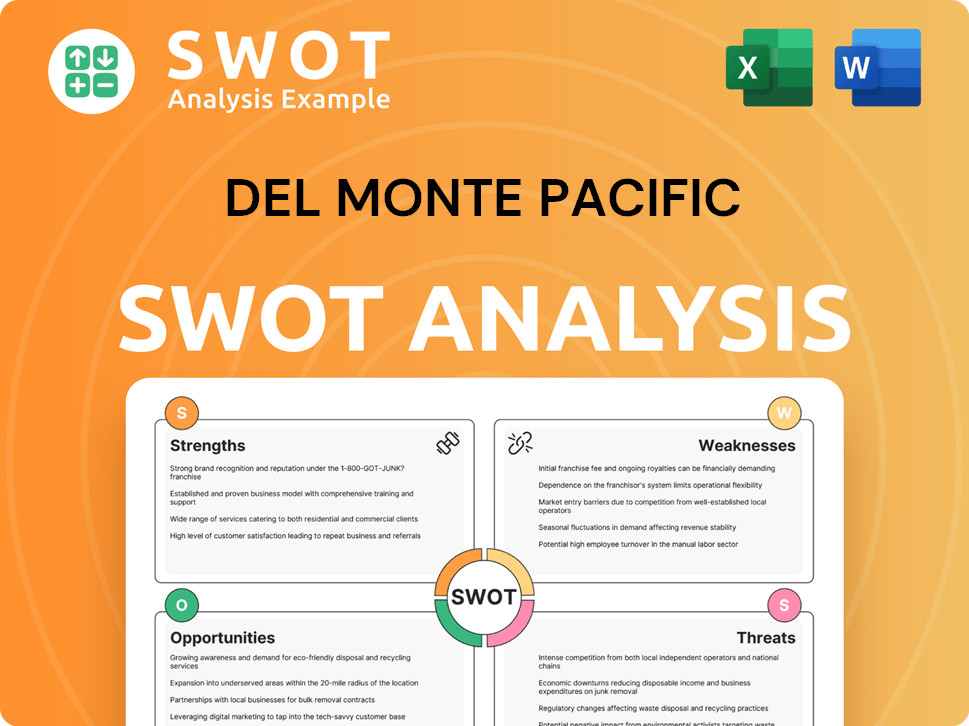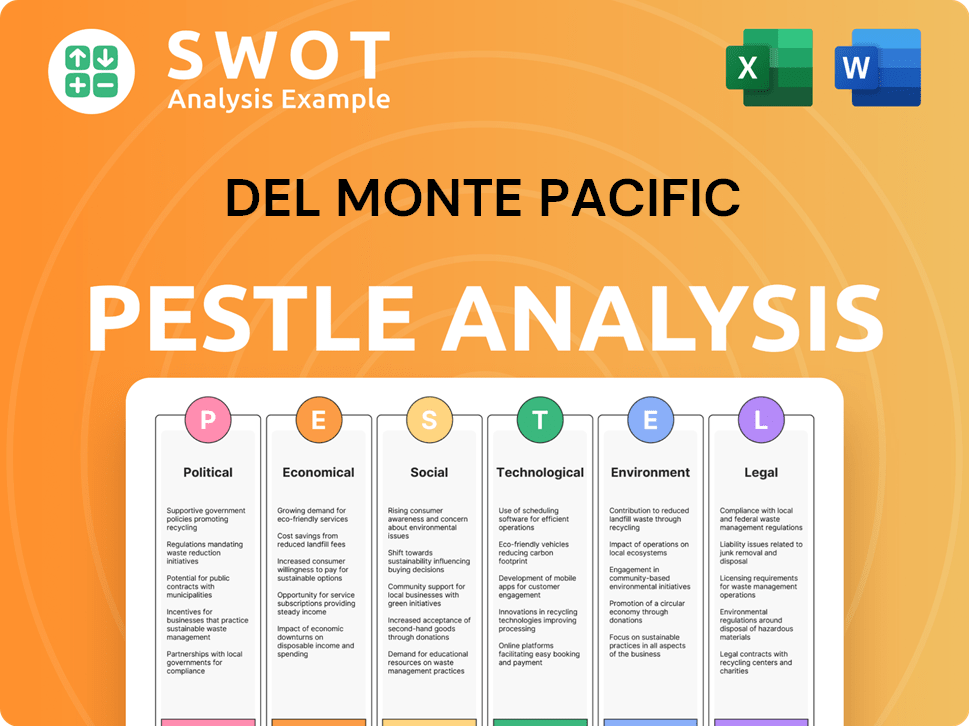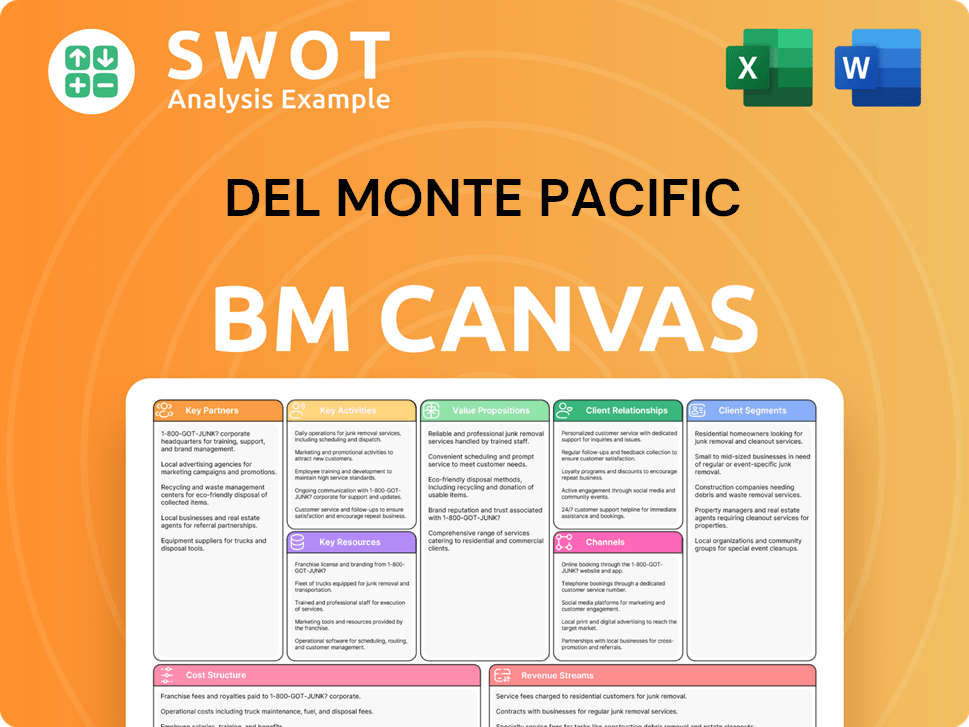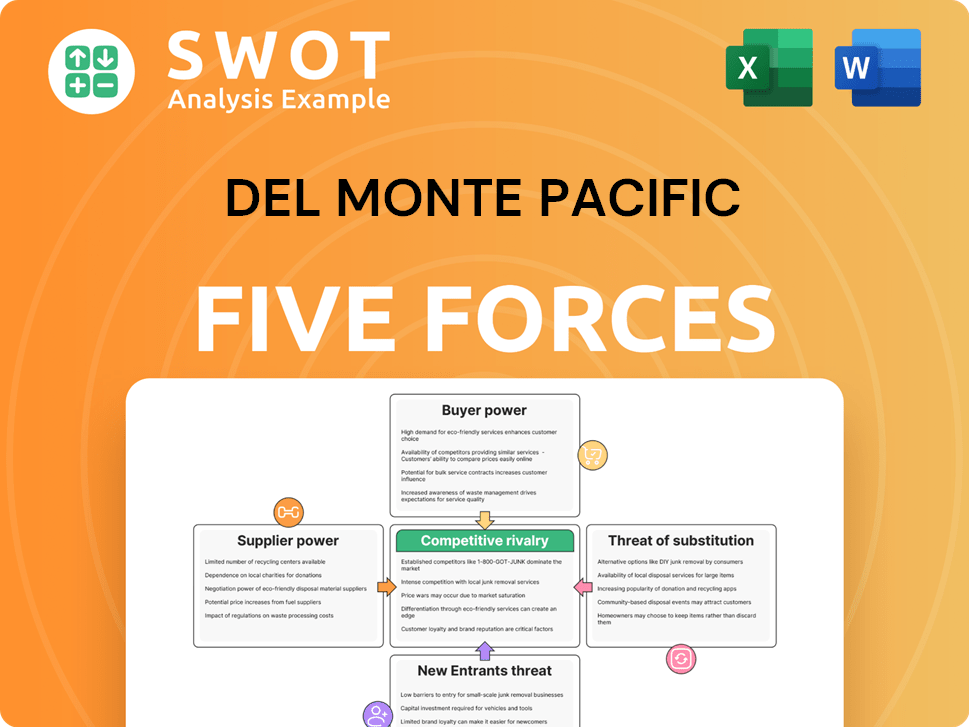Del Monte Pacific Bundle
Can Del Monte Pacific Company Thrive in Today's Food Industry?
The food industry is a battlefield of shifting consumer tastes and relentless competition. Del Monte Pacific Company (DMPL), a global player with roots stretching back to the 19th century, navigates this dynamic environment. Understanding its position within the competitive landscape is crucial for investors, strategists, and anyone seeking to understand the future of this iconic brand.

This analysis provides a comprehensive Del Monte Pacific SWOT Analysis, delving into the company's competitive advantages and challenges. We'll explore the market analysis of DMPL, examining its market share and key competitors within the food industry. This deep dive into Del Monte Pacific Company's competitive landscape will reveal its product portfolio, competitive strategies, and ultimately, its potential for long-term success, considering its global presence and the evolving consumer packaged goods market.
Where Does Del Monte Pacific’ Stand in the Current Market?
The market position of Del Monte Pacific Company (DMPL) is significant within the food industry, particularly in its core markets. In the Philippines, DMPL holds a dominant leadership position in several categories, including canned pineapple and pineapple juice, tomato sauce, and spaghetti sauce. The brand commands a substantial market share in these segments, showcasing its strong consumer presence.
In the United States, through its subsidiary Del Monte Foods, Inc. (DMFI), the company is a leading producer of canned fruits and vegetables. DMFI holds strong positions in categories like canned fruit, canned vegetables, and fruit snacks. While specific market share data for 2024-2025 is subject to ongoing market research, DMFI consistently ranks among the top brands in these traditional segments. A detailed market analysis of Del Monte Pacific Company can provide further insights into its competitive standing.
DMPL's primary product lines include packaged fruits and vegetables, beverage products (including juices), culinary sauces and condiments, and fresh pineapples. Its geographic presence is concentrated in the Philippines, the United States, and the broader Asia-Pacific region. The company has diversified its offerings beyond traditional canned goods, venturing into higher-value categories to meet evolving consumer preferences.
DMPL maintains a strong market presence, particularly in the Philippines and the United States. In the Philippines, it leads in canned pineapple, pineapple juice, tomato sauce, and spaghetti sauce. DMFI is a leading producer of canned fruits and vegetables in the United States.
DMPL's product range includes packaged fruits and vegetables, beverages, sauces, and fresh pineapples. The company has expanded into higher-value categories like ready-to-drink juices and culinary products. This diversification helps cater to changing consumer demands for convenience and health-conscious options.
DMFI reported net sales of $1.7 billion for the fiscal year ended April 28, 2023. Del Monte Pacific Limited reported sales of $2.3 billion for the nine months ended January 31, 2024. These figures highlight DMPL's significant scale within the food industry.
DMPL's primary markets are the Philippines, the United States, and the Asia-Pacific region. The company focuses on growth in emerging markets and product innovation. Adaptation to consumer demand and supply chain dynamics is key.
Del Monte Pacific Company's market position is characterized by strong leadership in core segments and a strategic focus on product diversification and geographic expansion. The company's financial performance reflects its scale and resilience in the competitive landscape of the consumer packaged goods industry. DMPL's ability to adapt to changing consumer preferences and market dynamics is crucial for its continued success.
- Dominant market share in canned pineapple and juice, tomato sauce, and spaghetti sauce in the Philippines.
- Leading producer of canned fruits and vegetables in the United States through DMFI.
- Focus on higher-value categories and expansion into emerging markets.
- Resilient financial performance with significant sales figures in 2023 and early 2024.
Del Monte Pacific SWOT Analysis
- Complete SWOT Breakdown
- Fully Customizable
- Editable in Excel & Word
- Professional Formatting
- Investor-Ready Format

Who Are the Main Competitors Challenging Del Monte Pacific?
The Competitive landscape for Del Monte Pacific Company (DMPL) is shaped by a mix of global and regional players. The company faces challenges and opportunities in various segments, including packaged fruits and vegetables, culinary sauces and condiments, and beverages. Understanding the market analysis of its competitors is crucial for Del Monte Pacific Company to maintain its market position and drive growth.
Del Monte Pacific Company must continuously monitor the actions of its rivals and adapt its strategies to stay competitive. The food industry is dynamic, with mergers, acquisitions, and the rise of new players constantly reshaping the competitive landscape. DMPL's ability to respond effectively to these changes will be key to its success in the long run.
In the packaged fruits and vegetables sector, Del Monte Pacific Company, through Del Monte Foods, Inc. (DMFI), competes with several key players. A deeper dive into the Brief History of Del Monte Pacific can offer more context. Dole Food Company is a major competitor, offering a wide range of fresh and packaged fruits. Private label brands from major retailers also pose a significant challenge, primarily competing on price. Seneca Foods, specializing in canned vegetables, and Green Giant, known for its frozen and canned vegetables, are also important competitors.
Del Monte Pacific Company faces competition from Dole Food Company, known for its extensive product range.
Private label brands from major retailers compete on price, putting pressure on profit margins.
Seneca Foods and Green Giant are key competitors in the canned and frozen vegetable segments.
NutriAsia, Inc. is a dominant player in the Philippines, offering a wide range of sauces and condiments.
Multinational corporations like Unilever and Nestlé compete with various culinary products.
These competitors leverage strong brand equity and extensive distribution networks.
The Coca-Cola Company (Minute Maid) and PepsiCo (Tropicana) are major competitors in the juice market.
Local and regional juice manufacturers also contribute to the competitive environment.
Competition focuses on product innovation and marketing campaigns.
Direct-to-consumer (D2C) brands are disrupting the traditional competitive landscape, particularly in niche healthy food segments.
Mergers and acquisitions continue to reshape the industry.
Del Monte Pacific Company must adapt to these evolving dynamics.
Del Monte Pacific Company must continuously monitor competitive movements.
Adapting strategies is crucial to maintain market position.
Pursuing growth opportunities is essential for long-term success.
The food industry is subject to constant change.
Mergers and acquisitions can create larger, more powerful entities.
Del Monte Pacific Company needs to be agile and responsive.
In the culinary sauces and condiments category, particularly in the Philippines, Del Monte Pacific Company faces competition from NutriAsia, Inc., a major player with a wide range of products, and multinational corporations such as Unilever and Nestlé. In the beverage sector, DMPL competes with global beverage companies such as The Coca-Cola Company (Minute Maid) and PepsiCo (Tropicana).
- Distribution Networks: Extensive reach is critical for product availability.
- Pricing Strategies: Competitive pricing is essential to attract consumers.
- Product Innovation: Developing new and appealing products is crucial.
- Marketing and Branding: Strong brand recognition and marketing campaigns are vital.
- Health and Wellness Trends: Adapting to consumer preferences for healthier options.
Del Monte Pacific PESTLE Analysis
- Covers All 6 PESTLE Categories
- No Research Needed – Save Hours of Work
- Built by Experts, Trusted by Consultants
- Instant Download, Ready to Use
- 100% Editable, Fully Customizable

What Gives Del Monte Pacific a Competitive Edge Over Its Rivals?
Analyzing the Del Monte Pacific Company (DMPL) requires a deep dive into its competitive advantages within the food industry. Understanding its market position and how it stacks up against rivals is crucial for any market analysis. This overview explores the key elements that define DMPL's success and its strategic moves in the consumer packaged goods sector.
DMPL's sustained performance in the global food and beverage market is built on several core strengths. The company's brand equity, distribution networks, and operational efficiencies are key factors. This competitor analysis highlights how these advantages contribute to its overall competitive edge.
The company's strong brand recognition, particularly in canned fruits and vegetables, allows it to command premium pricing and maintain significant shelf space. This advantage is reinforced through consistent quality and effective marketing. Its extensive distribution networks, especially in the Philippines and the United States, ensure efficient product delivery and market penetration. Furthermore, DMPL benefits from economies of scale in its production and sourcing, leading to competitive pricing and healthy profit margins.
The 'Del Monte' brand has a history of over a century, enjoying high consumer recognition and trust globally, especially in canned fruits and vegetables. This strong brand loyalty allows DMPL to command premium pricing and maintain significant shelf space. The brand's legacy of consumer satisfaction and consistent quality reinforces its market position.
DMPL benefits from well-established distribution networks. In the Philippines, it has a deeply entrenched supply chain. In the United States, Del Monte Foods, Inc. (DMFI) leverages robust relationships with major retailers and a sophisticated logistics infrastructure. These networks are critical for efficient product delivery and market penetration.
As a large-scale producer, DMPL achieves cost efficiencies in raw material procurement and manufacturing. Its integrated operations, particularly in pineapple cultivation and processing, provide supply chain control and cost predictability. The company also invests in product innovation, adapting its offerings to meet evolving consumer demands.
DMPL continually adapts its offerings to meet evolving consumer demands for healthier, more convenient, and diverse food options. This ensures that its product portfolio remains relevant and competitive. The company's ability to innovate and respond to market trends is a key factor in its long-term success.
DMPL's competitive advantages include strong brand equity, extensive distribution networks, and economies of scale. These strengths enable the company to maintain a strong market position and achieve sustainable growth. For a detailed look at the company's financial performance and ownership structure, consider reading about the Owners & Shareholders of Del Monte Pacific.
- Brand Recognition: The 'Del Monte' brand is globally recognized and trusted.
- Distribution Network: Extensive networks ensure wide product availability.
- Operational Efficiency: Economies of scale in production and sourcing.
- Product Innovation: Adaptability to evolving consumer preferences.
Del Monte Pacific Business Model Canvas
- Complete 9-Block Business Model Canvas
- Effortlessly Communicate Your Business Strategy
- Investor-Ready BMC Format
- 100% Editable and Customizable
- Clear and Structured Layout

What Industry Trends Are Reshaping Del Monte Pacific’s Competitive Landscape?
The competitive landscape for Del Monte Pacific Company (DMPL) is significantly influenced by evolving industry trends, potential challenges, and emerging opportunities within the food industry. A thorough market analysis reveals that DMPL's strategic position is constantly reshaped by consumer preferences, technological advancements, and regulatory changes. Understanding these factors is crucial for assessing DMPL's future outlook and its ability to maintain a competitive edge in the consumer packaged goods sector.
DMPL's success hinges on its ability to navigate these dynamics effectively. The company's performance is closely tied to its product portfolio, market share, and financial performance, all of which are subject to intense scrutiny from both competitors and consumers. A comprehensive competitor analysis and an understanding of DMPL's competitive advantages are essential for formulating effective competitive strategies and ensuring long-term sustainability. To gain a deeper understanding of the company's financial aspects, you can read about the Revenue Streams & Business Model of Del Monte Pacific.
The food industry is experiencing a significant shift towards healthier and more sustainable products. Technological advancements in food processing and e-commerce are also transforming the industry. Regulatory changes concerning food labeling and environmental impact are influencing product development and operational practices. These trends shape the competitive landscape for DMPL, impacting its product portfolio and market position.
DMPL faces challenges such as declining demand for traditional canned goods in some markets and increased scrutiny on sugar content. Aggressive new competitors and global economic shifts, including inflationary pressures, also pose risks. These factors can erode market share and impact financial performance. Understanding these challenges is critical for DMPL's strategic planning and future outlook.
Opportunities for DMPL include the growing demand for convenient and healthy food solutions, especially in emerging markets. Product innovations, strategic partnerships, and investments in sustainable practices can open new revenue streams. These opportunities can enhance distribution and consumer engagement, bolstering brand reputation and appeal to environmentally conscious consumers.
DMPL's competitive strategies likely involve diversifying its product portfolio and leveraging its strong brand equity. Optimizing its supply chain for efficiency and sustainability and exploring digital channels are also key. These strategies are crucial for navigating challenges and capitalizing on opportunities to maintain a strong market position and achieve sustainable growth.
DMPL must adapt to evolving consumer preferences and market dynamics to remain competitive. The company's ability to innovate and respond to challenges will determine its success. Recent financial data and market analysis provide insights into DMPL's performance and potential for growth. In 2024, the global packaged food market was valued at approximately $3.5 trillion, with projections indicating continued growth, particularly in emerging markets.
- Product Innovation: Focus on healthier and plant-based options.
- Market Expansion: Target emerging markets with high growth potential.
- Supply Chain Optimization: Enhance efficiency and sustainability.
- Digital Engagement: Utilize e-commerce and digital platforms to connect with consumers.
Del Monte Pacific Porter's Five Forces Analysis
- Covers All 5 Competitive Forces in Detail
- Structured for Consultants, Students, and Founders
- 100% Editable in Microsoft Word & Excel
- Instant Digital Download – Use Immediately
- Compatible with Mac & PC – Fully Unlocked

Related Blogs
- What are Mission Vision & Core Values of Del Monte Pacific Company?
- What is Growth Strategy and Future Prospects of Del Monte Pacific Company?
- How Does Del Monte Pacific Company Work?
- What is Sales and Marketing Strategy of Del Monte Pacific Company?
- What is Brief History of Del Monte Pacific Company?
- Who Owns Del Monte Pacific Company?
- What is Customer Demographics and Target Market of Del Monte Pacific Company?
Disclaimer
All information, articles, and product details provided on this website are for general informational and educational purposes only. We do not claim any ownership over, nor do we intend to infringe upon, any trademarks, copyrights, logos, brand names, or other intellectual property mentioned or depicted on this site. Such intellectual property remains the property of its respective owners, and any references here are made solely for identification or informational purposes, without implying any affiliation, endorsement, or partnership.
We make no representations or warranties, express or implied, regarding the accuracy, completeness, or suitability of any content or products presented. Nothing on this website should be construed as legal, tax, investment, financial, medical, or other professional advice. In addition, no part of this site—including articles or product references—constitutes a solicitation, recommendation, endorsement, advertisement, or offer to buy or sell any securities, franchises, or other financial instruments, particularly in jurisdictions where such activity would be unlawful.
All content is of a general nature and may not address the specific circumstances of any individual or entity. It is not a substitute for professional advice or services. Any actions you take based on the information provided here are strictly at your own risk. You accept full responsibility for any decisions or outcomes arising from your use of this website and agree to release us from any liability in connection with your use of, or reliance upon, the content or products found herein.